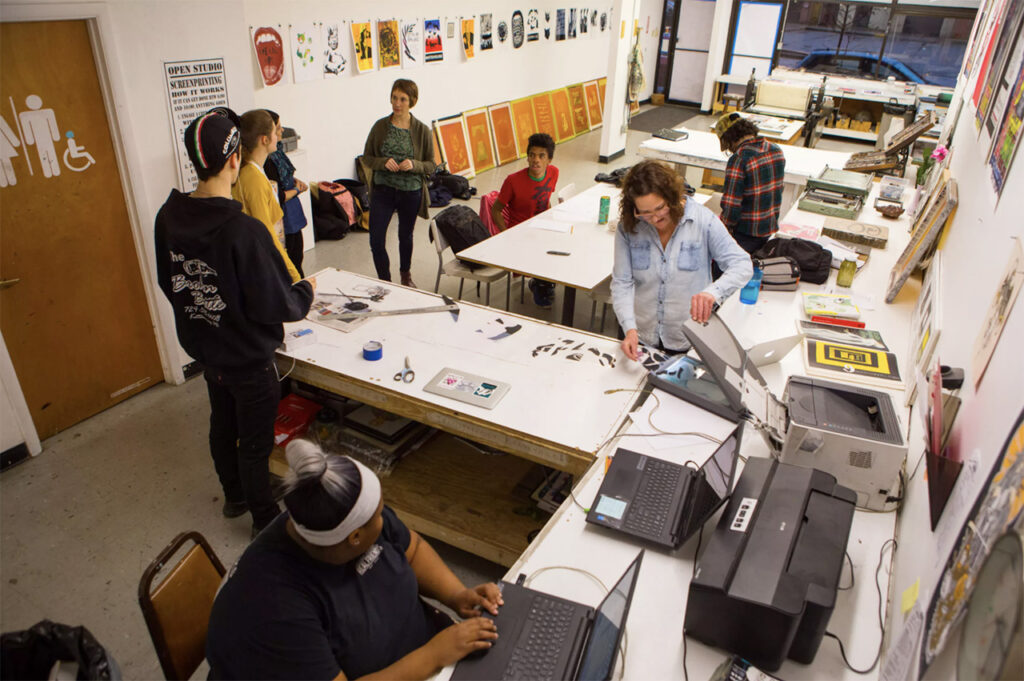Last November, the Andy Warhol Museum kicked off its TikTok page — itself not a news-making move, considering how the short-video platform has helped many a cultural institution deliver content straight to the heart of Gen Z. Karen Lautanen, the museum’s Senior Director for External Affairs, says as much: “The Warhol launched a TikTok account to expand and connect with a new and younger audience.” But, to better engage that younger demographic, the Pittsburgh institution has gone one step further by inviting these same teens to run the entire account.
So while @TheWarholMuseum does spotlight artworks and programs available at the venue, the voice and delivery of the TikTok account are unmistakably teenage, lending a brassy authenticity to the array of dances, lip-syncs, memes, and comedic bits. Hired as part of the museum’s workforce development program, which launched in September 2021, these young creators are responsible for planning and creating content for the account, in turn gaining skills not limited to project management, communication, and digital production.
An ongoing initiative, this partnership will only deepen as the institution continues to work with the teens to develop new series and repurpose its TikTok content for Reels on Instagram. Lautanen shares more below about how the collaborative project builds on the Warhol Museum’s social media and community engagement strategies.

Since November 2021, the Andy Warhol Museum’s TikTok account has been run by young creators, recruited as part of the institution’s workforce development program. Images: @TheWarholMuseum on TikTok
Why the decision to put the Andy Warhol Museum’s TikTok account in the hands of teens?
TikTok is immediate, not overly produced, and provides easily consumed soundbites of information — a platform by and for young people. We decided to view this platform through the eyes of the young people who consume it.
How were the young participants recruited? What did the museum look out for in candidates?
The Warhol is partnering with a creative agency here in Pittsburgh called Built Different. Teens and young people power this agency, and they recruit young, diverse students from local high schools and universities. They look for candidates who want to build careers in digital marketing, communications, and branding.
What creative brief did the teens receive with regards to the assignment?
Initially, the teens learn about the life and legacy of Andy Warhol, and the museum’s permanent collection of paintings, archives, film, and video. We also share museum best practices around rights and reproduction, accessibility standards, and The Warhol brand. We encourage the teens to be creative in their approach, develop series content, and utilize TikTok trends to connect with the wider audience.
What has the response been within The Warhol to the content created by the teens on TikTok?
I think the response has been very positive. It has forced the museum to be more responsive. Our museum director, Patrick Moore, has really taken the teens under his producer wing, and I think this is a unique professional development opportunity for the teens as well.
More broadly, how would you describe The Warhol’s approach to social media?
Broadly speaking, the museum has developed a strategy for each platform according to the particular platform’s strengths and intentions. The platforms dictate the usage, from informational to visual to storytelling. Not all platforms have the same strengths and each has its own version of “trends” or ways in which people receive our information in their feed.
Social media plays a critical role for us. Our social media strategy is a constant balancing act between information about the museum and its programming, and our desire to expand our audience or showcase new content. Although the museum is in Pittsburgh, Andy Warhol is a global brand, and social media allows us to connect with our audience, increase museum attendance both in person and online, and advertise our partnerships and sponsors.

The Warhol has actively engaged with its community through programs like Artists in Schools partnership initiative, Youth Open Studio (above), and a host of art-making and educator workshops. Image: Sean Carroll / The Andy Warhol Museum
Could you also elaborate on The Warhol’s workforce development program?
The museum’s workforce development program was inspired by a simple question that we asked ourselves: “Why do we matter?” We started thinking about the role of museums in society and the role of museums in their immediate communities. What were the future needs of our community and what role could we play in helping to meet these future needs?
Our museum is located in Pittsburgh, PA, the site of many industrial and information age revolutions, and museums, especially in their learning and public engagement, have always traded in 21st century skills. These are the skills of the future. We have found some terrific partners in local foundations like the Richard King Mellon Foundation, which is supporting us as we develop these programs and potentially build a creative agency within the museum itself.
Why is such community engagement important to the museum?
The Warhol has had a long history of community outreach through its Artists in Schools partnerships, teen programs, Youth Arts Council, Pride Prom, free online educational materials and curriculum, as well as online and in-person guided tours. The Warhol has always been more than a museum. It is a place of inspiration and self-discovery, a home for people who did not feel that they “fit” anywhere, and like Warhol, is constantly reinventing itself by bringing contemporary artists and performance to the people of the Pittsburgh region and beyond.



